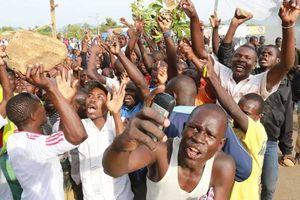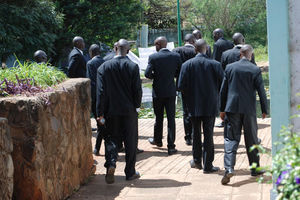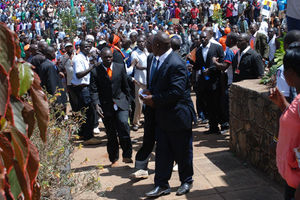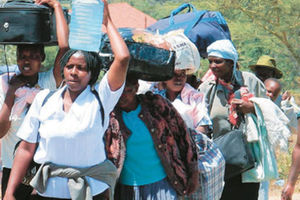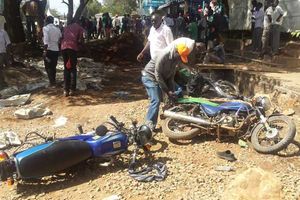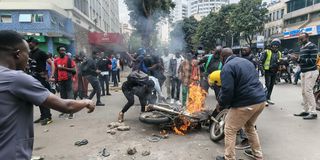
Chaos on Koinange Street in the Nairobi CBD as motorbike riders clashed with thugs carrying batons. The goons' bike was set on fire.
On Tuesday, June 17, 2025, in Nairobi, history returned with a clenched fist. A group of armed goons, clad in plain clothes and faces cloaked in masks, descended upon a peaceful assembly of civil society actors.
Their target was clear; to disrupt the surging pro-democracy activists and Gen Zs who had, in recent months, become a thorn in the side of the country’s political establishment.
The assault was swift, brutal and surgical. Police arrived and did what they have done for decades; shot at the innocent and dispersed the peaceful. To those familiar with Kenya’s political terrain, this was no aberration. This was a resurrection.
Kenya’s political system has always relied on violent intermediaries to do its dirtiest work. During the colonial period, the British built a regime of indirect rule, empowering local chiefs, tribal police, and loyalist militias to discipline African populations. These intermediaries — chiefs, headmen, home guards — were African agents of imperial violence, authorised to whip, evict, arrest, and, during the Mau Mau war, to kill.
Today’s goons — like those who struck on June 17— are their heirs. They are not anomalies. They are products of an enduring structure, born in the colonial state and perfected in the post-colony. They do not merely disrupt rallies or beat activists; they communicate power, reminding the public that politics in Kenya is still enforced through fear.
Frantz Fanon, in The Wretched of the Earth, warned us about this figure —the Black man with a colonial rifle, the native given power to punish other natives. “The intermediary,” Fanon wrote, “does not soften oppression. He is the bringer of violence into the home and into the mind of the native.”
If you read Achille Mbembe’s concept of necropolitics, you will grasp the logic that governs this violence. In the colony—and in its post-colonial afterlife—sovereignty is not just about governing life but deciding who may die, or suffer, or be erased. The goon, in this framework, is a proxy of death, operating in the grey zone where law is suspended and violence is normalised.
The June 17 attack was more than a beating. It was a performance of necro-politics, a moment in which the state, through silence and inaction, affirmed its right to allow violence to unfold. The goon is not a rogue actor. He is licensed through silence, empowered via absence, and protected through the convenient invisibility of informal violence.
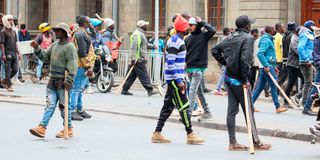
Goons on Moi Avenue in Nairobi on June 17, 2025 during protests following the death of Kenyan blogger Albert Ojwang.
Kenya has long lived with the fiction that political violence is episodic, erupting only during elections or moments of crisis. But history suggests otherwise; violence has always been embedded in the structure of the state, a strategic instrument wielded by those in power to silence, subdue, and suppress dissent. It has become a form of governance, a tool of negotiation, and a warning to those who speak too loudly.
In truth, June 17 was not a rupture but a continuation—a flashpoint in Kenya’s chronic condition of political violence. This violence is not the product of spontaneous thuggery, but rather the continued deployment of violent intermediaries: shadowy enforcers who carry out the will of political power without ever wearing its uniform.
Goons have a long and well-documented history in Kenya, whether formalised within party structures—as with the Kanu Youth Wing of yesteryears—or operating in more discreet formations, such as the Orange Democratic Movement’s notorious “Men in Black.” In 2014, this group infamously disrupted ODM’s internal elections at the Kasarani Gymnasium, storming the venue in matching black suits, overturning ballot boxes, scattering ballot papers, and bringing the proceedings to a violent halt.
Earlier, the most infamous of these formations was Youth for Kanu ’92, or YK’92 — a movement that masqueraded as a voter mobilisation arm, but quickly transformed into a highly funded, often violent political machine. Its methods ranged from vote-buying and ethnic incitement to outright physical intimidation and orchestrated street violence.
Financed by shadowy state channels and fronted by ambitious young men, it represented a fusion of patronage and paramilitary logic. Its members — and President William Ruto comes from that background — learnt that political success was tethered to the manipulation of fear. YK’92 cemented a dangerous precedent; that youth could be militarised as instruments of elite preservation, paid to act outside the law and protected from its consequences.
Political violence
During the 1998 Akiwumi Commission — convened to investigate the wave of ethnic and political violence that swept the country between 1991 and 1998—a stark reality emerged; the violence was not spontaneous chaos but a well-oiled machine. Politicians funded militias, security agencies turned a blind eye, and the ruling Kanu nurtured gangs as informal enforcers. The commission suggested that violence was not a failure of the system—it was the system.
Among the most infamous of Kenya’s state-sanctioned militias was Jeshi la Mzee — the Old Man’s Army — a ragtag but ruthlessly efficient corps of youthful enforcers loyal to the ruling party, Kanu. Far from clandestine, this outfit operated in plain sight, wielding crude weapons and political impunity in equal measure. Tasked with stifling dissent during the clamour for constitutional reform in the 1990s, Jeshi la Mzee became synonymous with organised terror. In one unforgettable incident, police officers stood idly by as its members publicly assaulted Rev Timothy Njoya for daring to demand democratic change.

A goon carrying a stone along Moi Avenue in Nairobi on June 17, 2025, during protests following the death of Kenyan blogger Albert Ojwang, who died in police custody.
In Parliament, then-Westlands MP Fred Gumo was named as the group's financial patron — a revelation that sent ripples through the fragile architecture of Kenya’s democratic transition. In response, a counterforce threatened to emerge: Jeshi la Embakasi, marshalled by Embakasi MP David Mwenje in a theatrical show of political brinkmanship.
Other shadowy militias began to mushroom across the political landscape, each more chilling than the last. The Taliban, a Luo-aligned gang, and the Mungiki, a clandestine Kikuyu sect steeped in ritual and fear, both rose to prominence. Politicians, seeing their utility in both mobilising and menacing, quietly funnelled resources to these groups — turning them into instruments of power, proxies of violence, and grim reflections of a democracy under siege. Mungiki’s [former] leader, Maina Njenga, continues to be courted by politicians in seeking to marshal grassroots support in the Mt Kenya region.
The Coast Province told a similar story. In the early 1990s, as the Islamic Party of Kenya (IPK) began mobilising politically, Kanu struck back through a proxy outfit called United Muslims of Kenya (UMKE), later renamed United Muslims of Africa (UMA). Led by Omar Masumbuko, and allegedly sanctioned by senior State House officials, UMA launched a campaign of terror; petrol bombings, targeted beatings, and kidnappings aimed at neutralising the IPK.
The playbook was clear; organise youth, arm them, pay them, unleash them — and when the dust settles, offer them jobs or let them disappear into the city’s underworld.
Political goons
Today’s political goons are descendants of that legacy. Their tools are the same—machetes, batons, crude communication networks. Their sponsors remain comfortably hidden behind the curtains of power, often denying knowledge while benefiting from the fear they sow.

An anti-riot police officer escorts armed goons who disrupted peaceful protests Nairobi on June 17, 2025 over the death of Albert Ojwang in police custody.
Mahmood Mamdani, in his book Citizen and Subject, explains how the colonial state in Africa was bifurcated; while settlers lived under civil law, the colonised were ruled through customary law enforced by despotic local authorities. These chiefs, as violent intermediaries, were institutionalised and formed the very architecture of colonial governance.
This is not a dead history. Postcolonial Kenya did not dismantle this system; it Africanised and adapted it. The police would still invite violent intermediaries to kill within their cells, and it appears that violence is still administered from a distance and accountability is dissolved into a haze of deniability.
The goon, then, is not just a person. He is a technology of rule — a way of governing without appearing to govern, a way of repressing without fingerprints. In this sense, June 17 was not an aberration. It was an iteration of a pattern.
The June 17 attackers are precisely this: not just “thugs,” but functionaries of a deeper structure of oppression, one in which violence is outsourced, and the coloniser’s whip is replaced by the politician’s goon. In attacking a fellow citizen, they do more than harm a body—they perform a psychic reordering, reminding the people of their place in a hierarchy of fear.
The activist targeted had, in the months prior, criticised creeping authoritarianism, condemned the shrinking civic space, and exposed alleged corruption involving key political figures and accountability by the police after a blogger, Albert Ojwang, was killed in police cells.
To confront political violence in Kenya today, we must see the goon as a political instrument, refined over generations, deployed in different ethnic costumes, and animated by the same logic: that sovereignty flows not from legitimacy, but from the capacity to terrify without taking responsibility. Until that machinery is dismantled — not cosmetically, but structurally—the goon will continue to emerge at moments of crisis, his face masked, his target familiar, his mission clear.
John Kamau is a PhD candidate at the Department of History, University of Toronto, Canada. Email: [email protected]; X: @Johnkamau1

